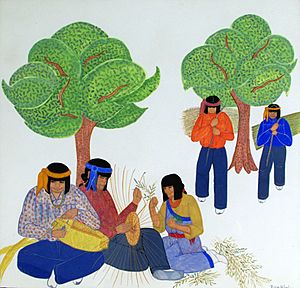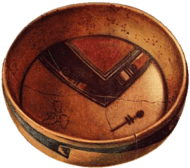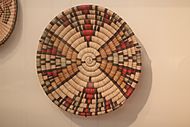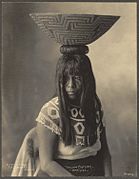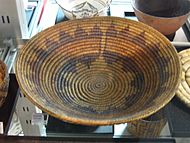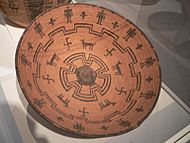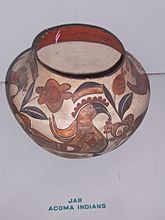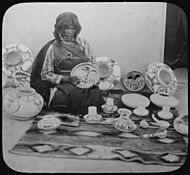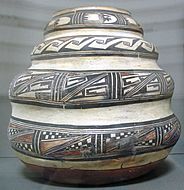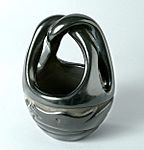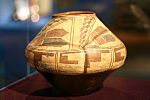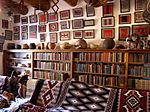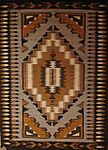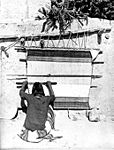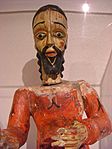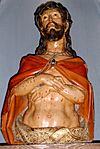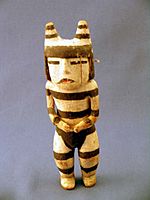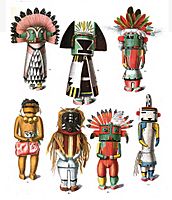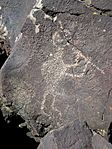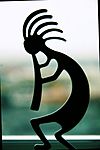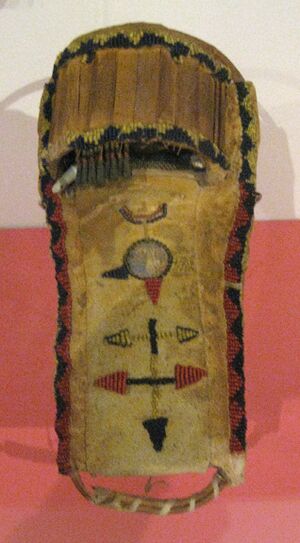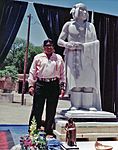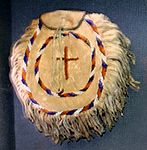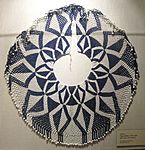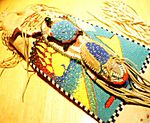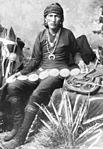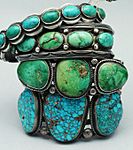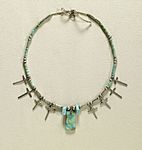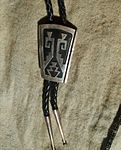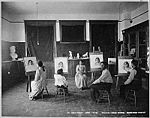Art of the American Southwest facts for kids
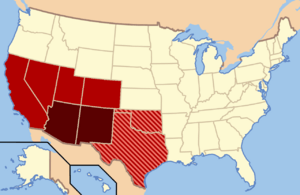
The Art of the American Southwest includes all the amazing visual arts from the Southwestern United States. This special area covers Arizona, New Mexico, and parts of other states like California and Colorado. People in this region have created art for thousands of years, from ancient times to today. This art includes architecture (buildings), pottery, painting, sculpture, and more.
Contents
History of Art in the Southwest
Ancient Puebloan People
The Ancestral Puebloans lived in the Southwest until about 1400 CE. They are the ancestors of today's Pueblo tribes. Their culture began about 4,000 years ago when they learned to grow corn. These people lived in settled towns and developed a farming lifestyle.
They made early pottery like gray pottery with wavy textures and black-on-white pottery. The wavy texture came from pinching coils of clay. Black-on-white pottery was often traded for food. Sikyátki, an old Hopi village, was known for its colorful pottery. The Hohokam culture also grew in Arizona around 300 CE. They are the ancestors of the Tohono O'odham and Akimel O'odham tribes. The Mimbres people were famous for their pottery with painted stories.
-
Anasazi bowl (for trade) from 900-1100 AD, found at Chaco Culture National Historical Park.
The Ancestral Pueblo people also used Turquoise, jet, and spiny oyster shells for jewelry. They were very skilled at inlay techniques, where they set small pieces of these materials into designs. The Ancestral Puebloans of Chaco Canyon were known for making and trading many turquoise items.
Native American Nations
Over the last thousand years, Athabaskan peoples, like the Navajo and Apache, moved to the Southwest from northern Canada. Sandpainting is a special part of Navajo healing ceremonies and has also become an art form.
Navajos learned to weave on upright looms from the Pueblos. They made blankets that were popular with other tribes in the 1700s and 1800s. When railroads brought cheaper blankets in the 1880s, Navajo weavers started making rugs for trade instead.
Pueblo, Navajo, and Apache tribes loved turquoise. They believed it had special powers. The Apache thought it helped archers aim well. These tribes used turquoise in mosaics, sculptures, and made beads and pendants. The unique silver jewelry made by Navajo and other Southwestern Native American tribes today started around 1880, influenced by Europeans.
Colonial Spanish Influence
Many Hispanic people in the Southwest needed to make their own things. They used skills like woodworking, weaving, tinsmithing, and leather work. This helped them create furniture and items for their homes.
Anglo-American Influence
When European Americans began settling in the Southwest, they were drawn to the ancient art traditions of the native people. This rich history of native crafts made the area very appealing to Anglo-American artists.
Mixing of Art Styles
Native artists in the Southwest started working with silver around the 1850s. This happened when Mexican silversmiths traded their silverwork with the Navajo. The Zuni admired the silver jewelry made by the Navajos, like Atsidi Sani (Old Smith). So, they traded livestock to learn silverworking. By 1890, the Zuni had taught the Hopi how to make silver jewelry.
Native Americans also learned about oil and watercolor painting on canvas. Before, they usually painted on things like animal hides or inside buildings, such as on kiva walls. Native American paintings showed real Native American life, unlike the more romantic pictures made by Anglo-Americans. The Studio at the Santa Fe Indian School helped formalize traditional designs. This led to a style called "flatstyle Native American art." Dorothy Dunn started the Studio in 1932. Later, Geronima Cruz Montoya taught there until it closed in 1962. Then, the Institute of American Indian Arts was created.
After World War I, the Santa Fe Railroad made it easier for American settlers to travel west. New artist communities grew around Santa Fe and Taos. These artists mostly painted the native people and landscapes of the Southwest. Images of the Southwest became popular in advertising, especially for the Santa Fe Railroad, to encourage people to move west. Famous artists of this time include Walter Ufer, Georgia O'Keeffe, and others.
Basketry
Native Americans in the Southwest have traditionally made baskets using materials found in their local areas.
-
Apache basket bowls and ollas, photo by Edward S. Curtis.
-
Hopi coiled basket, made around 1901.
-
Yellow Feather (Maricopa), photo by Frank A. Rinehart, around 1898.
-
Luzi (Tohono O'odham) with a coiled burden basket, photo by Edward S. Curtis.
-
Yavapai flat, coiled willow basket, at Stanford University.
Pottery
Acoma Pottery
Acoma pottery began over 1,000 years ago. Traditional designs include thunderbirds, geometric shapes, and rainbows. The pottery is made from fine local clay, which makes the walls very thin. Acoma pottery is made in white, black, and other colors. Designs are sometimes pressed into white pottery using a fingernail or tool. Famous Acoma potters from the 1950s include Marie Z. Chino and Lucy M. Lewis.
-
Acoma Black-on-white olla by Lucy M. Lewis, from the 1960s–1970s.
-
Acoma Pueblo colorful jar, at the Field Museum of Natural History.
Hopi Pottery
In the past, Hopi people made pots, bowls, and other containers for daily use. They also made special ceremonial mugs, jugs, and seed jars. These were often polished and decorated with black designs. Making pottery is a social activity for the Hopi. Children are encouraged to play with clay. Becoming a potter as an adult shows "strength, maturity, and patience." Around 1900, Hopi potter Nampeyo brought back the Sikyatki-style colorful pottery from the 14th to 17th centuries.
Santa Clara Pottery
Santa Clara pottery is known for its red and shiny black colors. It is also special because designs are carved into the clay after it has dried a bit.
San Ildefonso Pottery
San Ildefonso pottery is famous for its black-on-black style. This style was brought back to the San Ildefonso Pueblo in the early 1900s by Maria Martinez and her husband Julian Martinez.
-
Maria and Julian Martinez blackware wedding vase, made around 1929.
-
Black-on-Black pottery from the pueblo, at the Field Museum of Natural History, Chicago.
Taos Pottery
Juanita Suazo Dubray is a Native American potter from Taos Pueblo. She makes micaceous pottery, continuing a tradition from her mother and ancestors. Dubray adds carved designs like corn, turtles, lizards, and kiva steps to her work.
Zuni Pottery
Zuni pottery is made from local clay. Before gathering the clay, the Zuni give thanks in a special ceremony. They paint the pottery with homemade natural dyes using a traditional yucca brush. The shape and designs of the pottery depend on what it will be used for. Firing the pottery was often a community event. People believed that being quiet or speaking softly was important to keep the original "voice" of the clay. Today, selling pottery and other traditional arts is a main source of income for many Zuni people.
-
Zuni olla, from the late 1800s or early 1900s, at the Brooklyn Museum.
Textiles
Dr. Joe Ben Wheat studied thousands of old textiles to help identify and date blankets from the Pueblo, Navajo, and Spanish American weaving traditions. His research led to an important book called "Blanket Weavings in the Southwest."
Navajo textiles, like handwoven blankets and rugs, are highly valued. They have been important to the Navajo economy for over 150 years. Navajo textiles were first made as useful blankets for cloaks, dresses, and saddle blankets. By the late 1800s, weavers started making rugs for tourists and for export. Navajo textiles often have strong geometric patterns. They are made using a flat tapestry-weaving style, similar to rugs from Eastern and Western Asia.
Hopi Weaving
Figures
Bultos
Bultos are three-dimensional, hand-carved religious figures, often of saints. Spanish-Mexicans introduced them.
Kachina Dolls
Kachina images appeared in ancient murals and rock carvings by 1300 AD. The Kachina religion was very important for the early Zuni and Hopi people.
Zuni and Hopi Kachina dolls are figures that represent spiritual beings. Hand-carved kachina dolls are given to young girls as gifts by Kachina dancers during ceremonies. In the 1800s, dolls were carved with simple tools, smoothed with stones and clay, and then painted with natural dyes. Zuni kachinas are believed to live in Arizona and bring good things like rain, success for hunters, and overall well-being.
There are over 400 different kachinas in Hopi and Pueblo culture. Each pueblo community has its own set of kachinas. There can be kachinas for the sun, stars, thunderstorms, wind, corn, and many other ideas.
-
Drawings of kachina dolls, from an 1894 anthropology book.
Kokopelli
Kokopelli is a hunchbacked flute player. He represents the spirit of music and is a Native American fertility deity. He is thought to watch over childbirth and agriculture. Kokopelli is one of the most easily recognized figures in the ancient rock carvings and paintings of the Southwest. The oldest known carving is from about 1000 AD. He is often part of marriage rituals. The Hopi sometimes show him with a woman called Kokopel Mana. Kokopelli is believed to chase away winter and bring the warmth and rains of spring with his flute music. Among the Hopi, Kokopelli carries unborn children on his back and gives them to women. His image is used in rock art, pottery, kachina dolls, and more.
Dolls and Toys
Navajo dolls were made by Navajo women. They were based on the full dresses worn by American women in the 1860s. Velvet was used instead of satin, and buttons were made from nickels and dimes.
Storyteller Dolls
A Storyteller doll is a clay figure of a person surrounded by listening children. These dolls are made by the Pueblo people of New Mexico. The first storyteller doll was made by Helen Cordero of the Cochiti Pueblo. She made it to honor her grandfather, who was a tribal storyteller.
Sculpture
-
For Life in all Directions, a bronze sculpture by Roxanne Swentzell (Santa Clara Pueblo).
-
Cliff Fragua and his statue of Popé at Ohkay Owingeh, 2005.
Jewelry
Turquoise, red spiny oyster, and jet have been used in Southwest jewelry for hundreds of years. Silverwork was introduced through trade in the 1800s. Atsidi Sani became a Navajo silversmith around 1853. Silverworking quickly spread to other tribes. Southwest silverwork includes designs like channel inlay, cluster, mosaic, and tiny point work. They use materials like shell, gemstones, and beads. The Navajo liked the squash blossom necklace and often combined turquoise, coral, and other semi-precious gemstones. Stones were set into silver designs and strung on cords for necklaces.
Hopi people are known for their overlay silver work, which they developed in the 1940s. Zuni artists are admired for their cluster work jewelry, which features many turquoise designs. They also create detailed, picture-like stone inlay in silver.
Beadwork
-
Hohokam turquoise mosaics, found in 1925 in Casa Grande Ruins National Monument, Arizona.
-
Apache beaded hide bag, at the Oklahoma History Center.
-
Mojave woman's beaded collar, from the 1930s–1940s, at the Heard Museum.
Silverwork
-
Pueblo necklace with turquoise heishe-style beads, early 1900s, at the Walters Art Museum.
-
Silver overlay bolo tie, by Tommy Singer (Navajo).
Spanish Tinwork
Tinware, likely brought from Mexico and Spain, was used for religious decorations and household items. This included things like sconces (wall lights) and mirrors. It became very popular in the mid-1800s.
Two-Dimensional Art
Paintings
-
Hide painting by Naiche (Chiricahua Apache), around 1900. It shows an Apache girl's puberty ceremony.
-
Chiricahua or Western Apache handpainted playing cards, from around 1875-1885.
Santos
Santos, which started in the late 1600s, are religious pictures painted on flat boards (called retablos) or carved from wood (called bultos).
Art Shows and Museums
Many yearly events showcase Southwestern art. The Southwestern Association for Indian Arts holds the Indian Market every August in Santa Fe, New Mexico. This event started in 1922. Also in 1922, the Gallup Inter-Tribal Indian Ceremonial began in Gallup, New Mexico. It features an art show and market. The Heard Museum Guild has held its Indian Art Fair since 1958 in Phoenix, Arizona. The Arizona State Museum on the University of Arizona in Tucson hosts the annual Southwest Indian Art Fair. The Museum of Northern Arizona in Flagstaff also hosts big art festivals for Southwest Native American and Hispanic peoples. The Santa Fe Spanish Market has two events each year: a Winter Market for new Hispanic arts and a July Spanish Market for classic Hispanic arts. These include santos, retablos, straw appliqué, colcha embroideries, tinwork, and more.


